Laos is a small landlocked country located in the heart of Southeast Asia. It is home to a rich variety of exotic and endemic birds, with more than 600 species recorded in the country.
Laos is a bird-watchers paradise, with many unique species for birders to observe. From the endangered Black-eared Lark to the colorful Bar-breasted Firefinch, Laos birds are an incredible sight to behold.
From the high-altitude wetlands of the Annamite Mountains to the lowland forests of the Mekong River Delta, there is a great diversity of habitats to explore.
1. Spotted Elachura
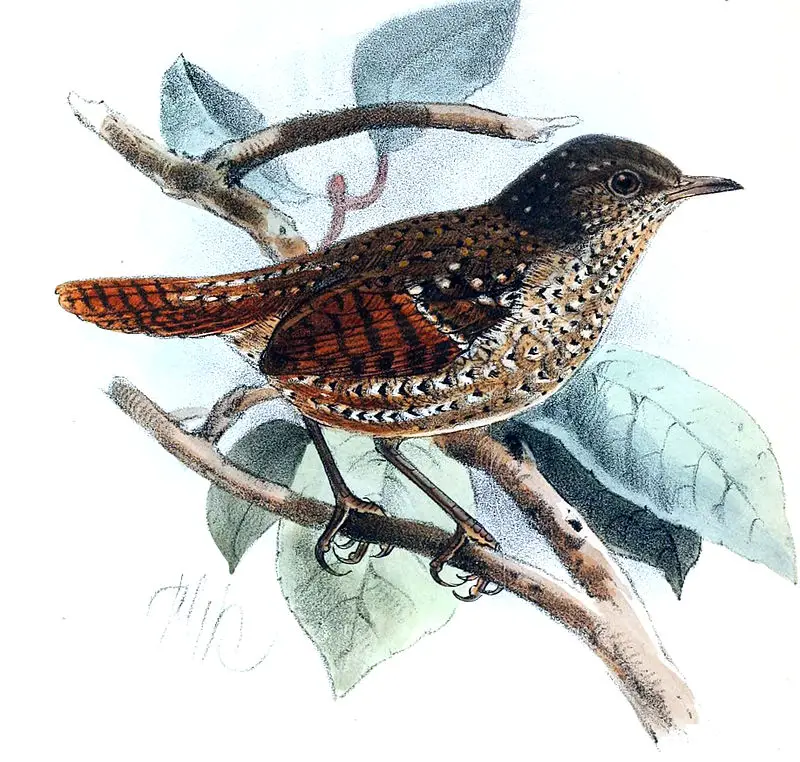
The Spotted elachura is a small passerine bird found in the forests of eastern Himalayas and Southeast Asia. It has an attractive plumage with white spots on its wings, back, head and chest.
Its diet consists mainly of insects and other invertebrates from leaves or tree trunks that it finds while foraging through foliage on branches near the ground.
Recent molecular studies have shown that this species diverged early from more commonly known babblers, forming its own distinct lineage.
This shy bird prefers to keep itself hidden among dense undergrowth but can sometimes be seen flitting around searching for food alone or in pairs during daytime hours.Scientific classification:
| Kingdom | Animalia |
| Phylum | Chordata |
| Class | Aves |
| Order | Passeriformes |
| Family | Elachuridae Alström et al., 2014 |
| Genus | Elachura Oates, 1889 |
| Species | E. formosa |
2. Bare-Faced Bulbul
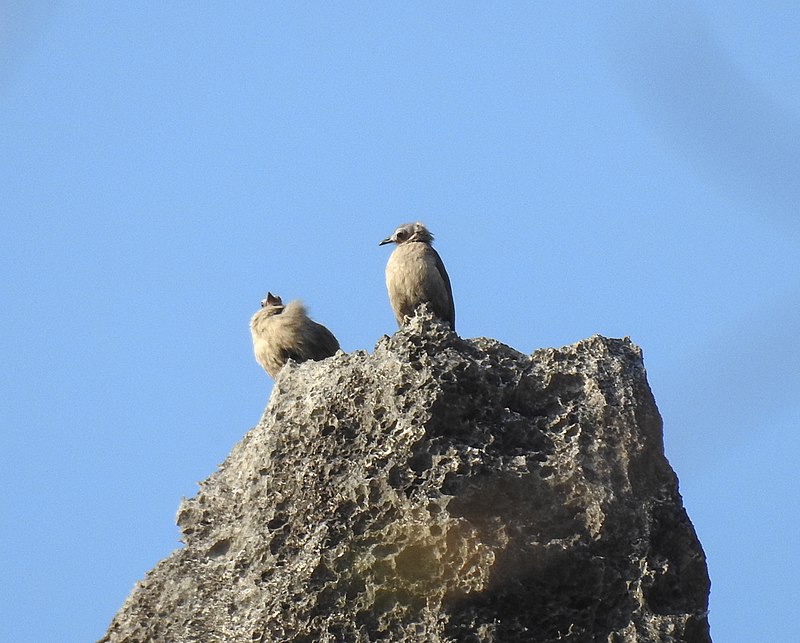
The Bare-faced Bulbul is a newly described species of passerine bird from the bulbul family. It has an unmistakable bald face, making it one of very few Asian songbirds with this feature.
Its scientific name hualon derives from the Lao word for ‘bald-headed’ and was only discovered in 2009 in central Laos – almost 100 years after any new species had been documented within its genus.
In 2018, molecular phylogenetic studies confirmed that this unique bird belongs to the Pycnonotus group – making it distinct among other bulbuls.
The Bare-faced Bulbul is found primarily in lowland tropical moist forests and feeds on fruit, flowers and insects which it captures by perching or hovering over vegetation before snatching its prey mid flight.Scientific classification:
| Kingdom | Animalia |
| Phylum | Chordata |
| Class | Aves |
| Order | Passeriformes |
| Family | Pycnonotidae |
| Genus | Nok Fuchs et al., 2017 |
| Species | N. hualon |
3. Black-Headed Woodpecker
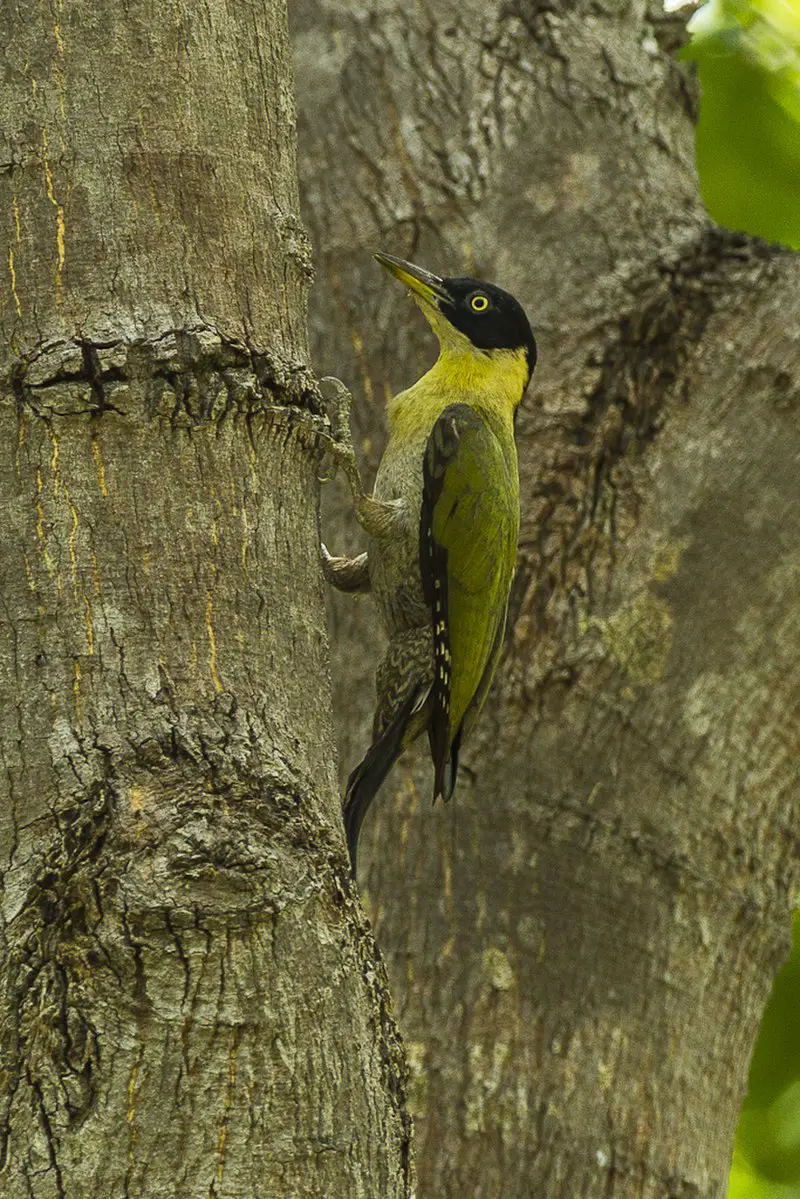
The Black-headed Woodpecker is a beautiful bird species found in Southeast Asia. It has striking plumage with black face, yellow throat and green wings, while its back and tail are red-brown or rufous.
The adult birds measure around 33 cm in length and weigh between 100 to 135 gm. They inhabit both deciduous as well as coniferous forests primarily located in Cambodia, Laos Myanmar, Thailand and Vietnam .
These woodpeckers feed on insects which they search for by probing at the base of tree trunks using their strong beaks.They also eat fruits from trees suchas figs , dates etc alongwith nuts that have been buried by squirrels.
Though not endangered yet these birds need our protection so that future generations can continue to enjoy them too .Scientific classification:
| Kingdom | Animalia |
| Phylum | Chordata |
| Class | Aves |
| Order | Piciformes |
| Family | Picidae |
| Genus | Picus |
| Species | P. erythropygius |
4. Black-Headed Greenfinch
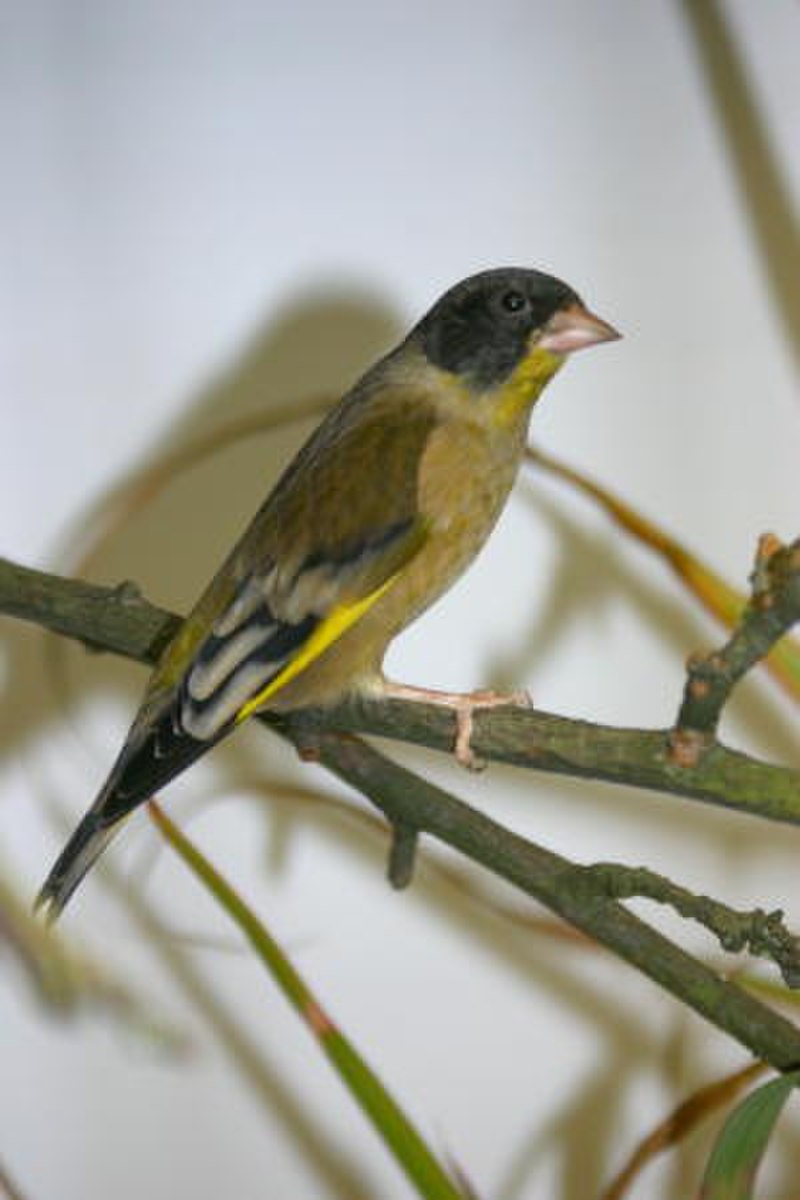
The black-headed greenfinch is a small passerine bird belonging to the Fringillidae family.
Found in Yunnan Province of China, northern Laos, eastern Myanmar and surrounding areas of Vietnam, Thailand and Northeast India, it inhabits dry subtropical or tropical forests as well as dry shrublands.
The finch has an olive-green body with a head that’s predominantly black but also showing some yellow patches.
It features bright red legs while its tail feathers are tipped with white creating an eye catching contrast against its dark plumage.
This species feeds mostly on grass seeds supplemented by insects during breeding season and can often be spotted foraging together in groups throughout their range.
Due to habitat loss caused by deforestation this species is at risk however there have been reports of successful conservation efforts taking place in certain areas helping protect the population from further declineScientific classification:
| Kingdom | Animalia |
| Phylum | Chordata |
| Class | Aves |
| Order | Passeriformes |
| Family | Fringillidae |
| Subfamily | Carduelinae |
| Genus | Chloris |
| Species | C. ambigua |
5. Tawny Fish Owl
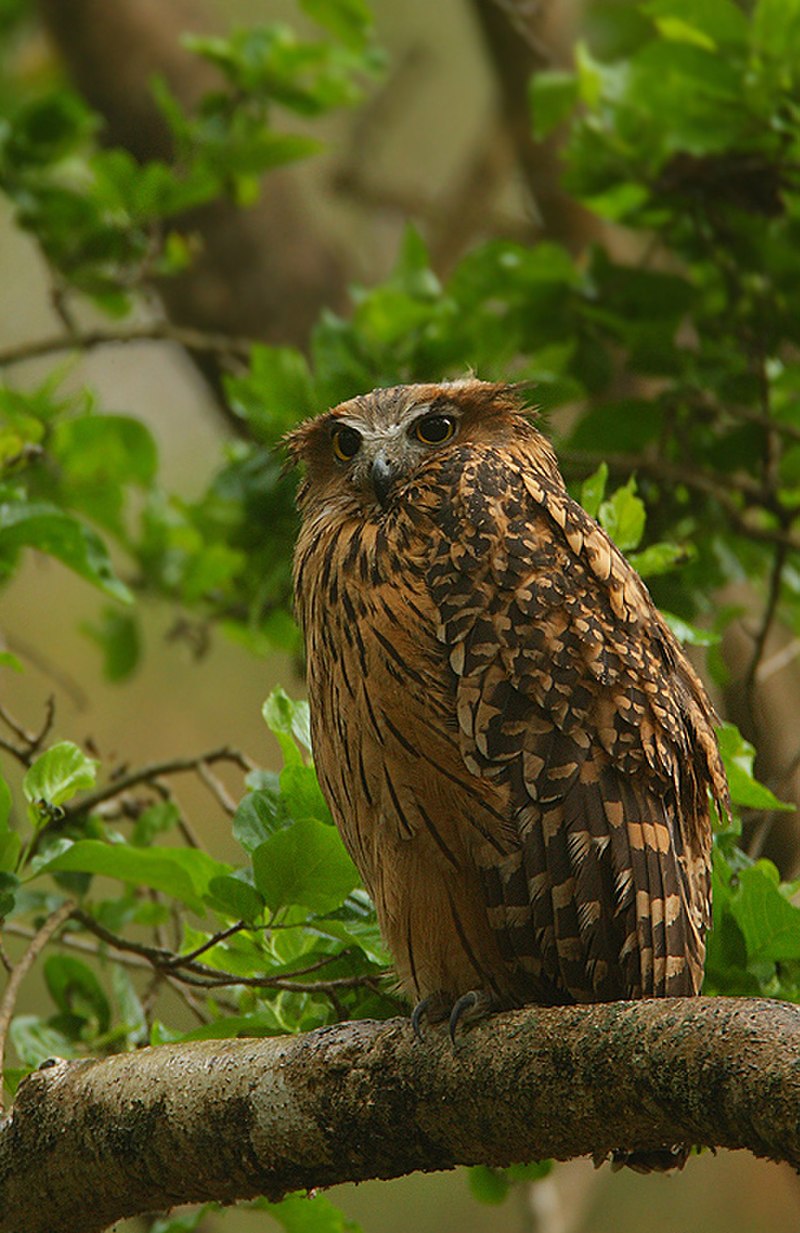
The Tawny Fish Owl is a species of owl native to southern Nepal, Bangladesh, Vietnam and China. It has yellow feet and was first described by Brian Houghton Hodgson in 1836.
This fish-eating bird feeds on small prey such as frogs and fish which it catches near rivers using its sharp talons.
The tawny coloration helps the owl blend into its natural environment, providing protection from predators while hunting for food at night or roosting during the day.
Its wide geographical range ensures that this species is listed as Least Concern by IUCN Red List due to its relatively stable populations across much of Asia despite some localized threats from human activities including habitat destruction and fragmentation through urban development .Scientific classification:
| Kingdom | Animalia |
| Phylum | Chordata |
| Class | Aves |
| Order | Strigiformes |
| Family | Strigidae |
| Genus | Ketupa |
| Species | K. flavipes |
6. Black-Tailed Crake
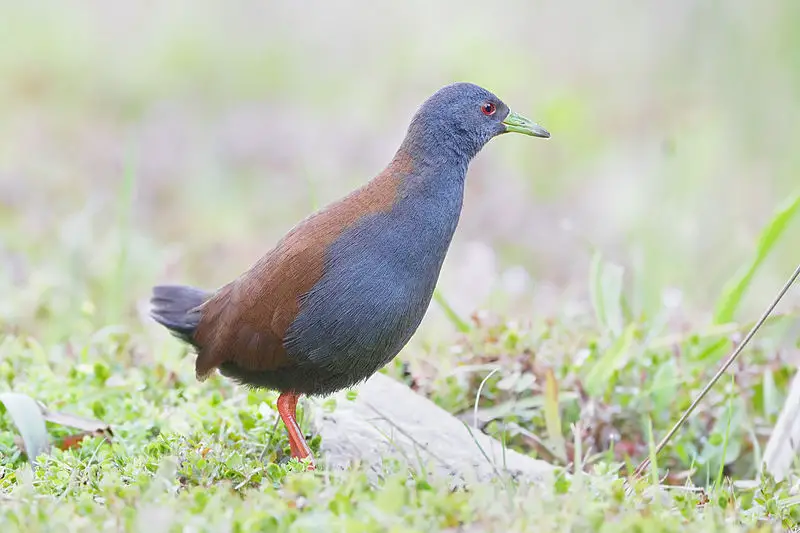
The Black-tailed Crake is an elegant bird found in many Asian countries such as Bangladesh, Bhutan, China, India and Myanmar. It has a distinctive slate gray colour with chestnut brown back feathers and red eyes that give it a striking appearance.
Its slender legs are coloured pinkish-red. The crake prefers to live in moist montane forests but can also be seen near ponds or rivers where there is plenty of vegetation for them to feed on.
They tend to stay close to the ground rather than fly high up into the trees like other species of birds do.
The black-tailed crake makes its home in subtropical or tropical areas which provide ideal conditions for these beautiful creatures.Scientific classification:
| Kingdom | Animalia |
| Phylum | Chordata |
| Class | Aves |
| Order | Gruiformes |
| Family | Rallidae |
| Genus | Zapornia |
| Species | Z. bicolor |
7. Fork-Tailed Sunbird
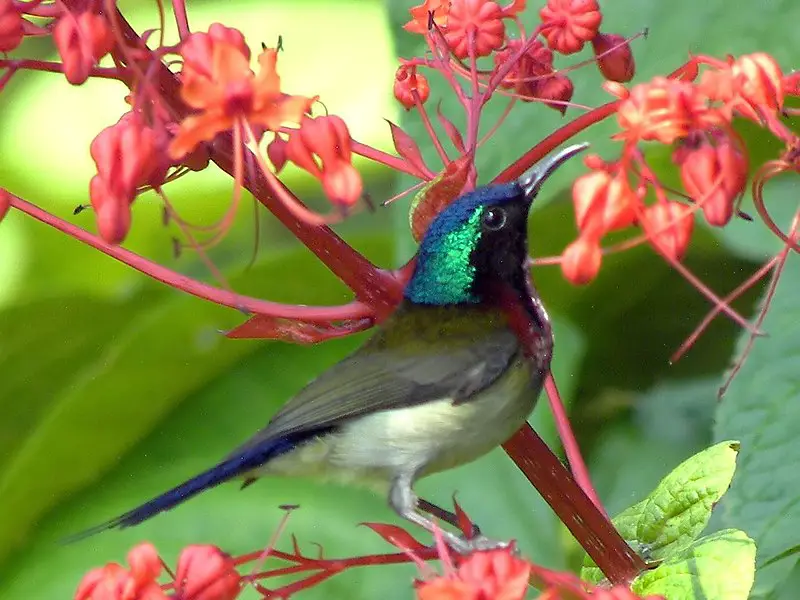
The Fork-tailed sunbird is a small, brightly colored bird found in China, Hong Kong, Laos and Vietnam. It has an unmistakable decurved bill and emits a soft “zwink-zwink” sound as well as a metallic trill.
Its natural habitat is subtropical or tropical moist lowland forests where it can be seen flitting among the trees searching for nectar with its long tongue.
This species was first described by Robert Swinhoe in 1869 and displays striking iridescent blue plumage on its throat while males have scarlet undertail coverts that contrast against their black tail feathers which are split at the end to create ‘forks’.
Females lack this feature but still possess vibrant yellow underparts. The fork-tailed sunbird plays an important role pollinating flowers throughout its range whilst providing us with a beautiful sight of nature’s diversity.Scientific classification:
| Kingdom | Animalia |
| Phylum | Chordata |
| Class | Aves |
| Order | Passeriformes |
| Family | Nectariniidae |
| Genus | Aethopyga |
| Species | A. christinae |
Also Featured In: Common Birds of Hainan,
8. Blue Pitta
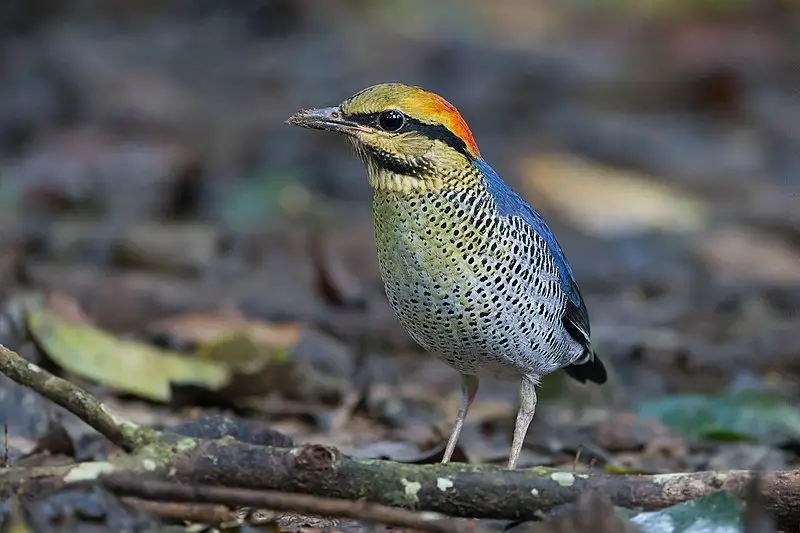
The Blue Pitta is a vibrant and beautiful bird that belongs to the family of Pittidae. It can be found in moist forests, dry forests, and across the northeastern Indian subcontinent, southern China, and Indochina.
They are generally solitary birds with stocky bodies characterized by their long tail feathers which contrast against their bright blue plumage.
The diet of these birds consists mainly of insects and other small invertebrates which they forage from the ground or low-lying trees.
Overall this species has adapted well to its environment though it remains relatively inconspicuous due to its shyness towards humansScientific classification:
| Kingdom | Animalia |
| Phylum | Chordata |
| Class | Aves |
| Order | Passeriformes |
| Family | Pittidae |
| Genus | Hydrornis |
| Species | H. cyaneus |
9. Bar-Bellied Pitta
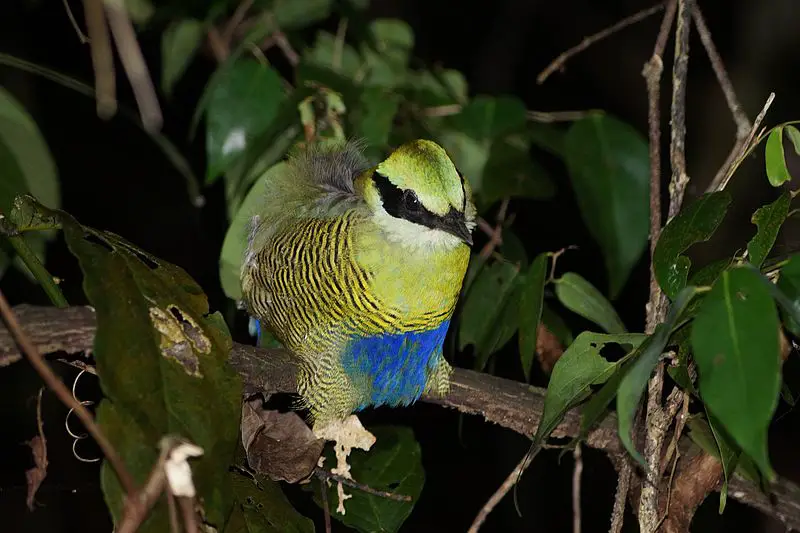
The Bar-bellied pitta is a species of bird in the Pittidae family, found in Cambodia, Laos, Thailand and Vietnam. It inhabits seasonal tropical forests and has an attractive plumage with blue upperparts and yellowish bars on its breast.
The male has a red head while females are duller overall but have bright orange underparts.
These birds feed mainly on invertebrates such as insects which they catch by hopping along the ground or gleaning from foliage. They also eat some fruit like wild figs or berries when available.
Their nests are built low to the ground within thick vegetation near streams; both parents share incubation duties for up to two weeks before chicks hatch out ready to explore their new world.Scientific classification:
| Kingdom | Animalia |
| Phylum | Chordata |
| Class | Aves |
| Order | Passeriformes |
| Family | Pittidae |
| Genus | Hydrornis |
| Species | H. elliotii |
10. Blue-Naped Pitta
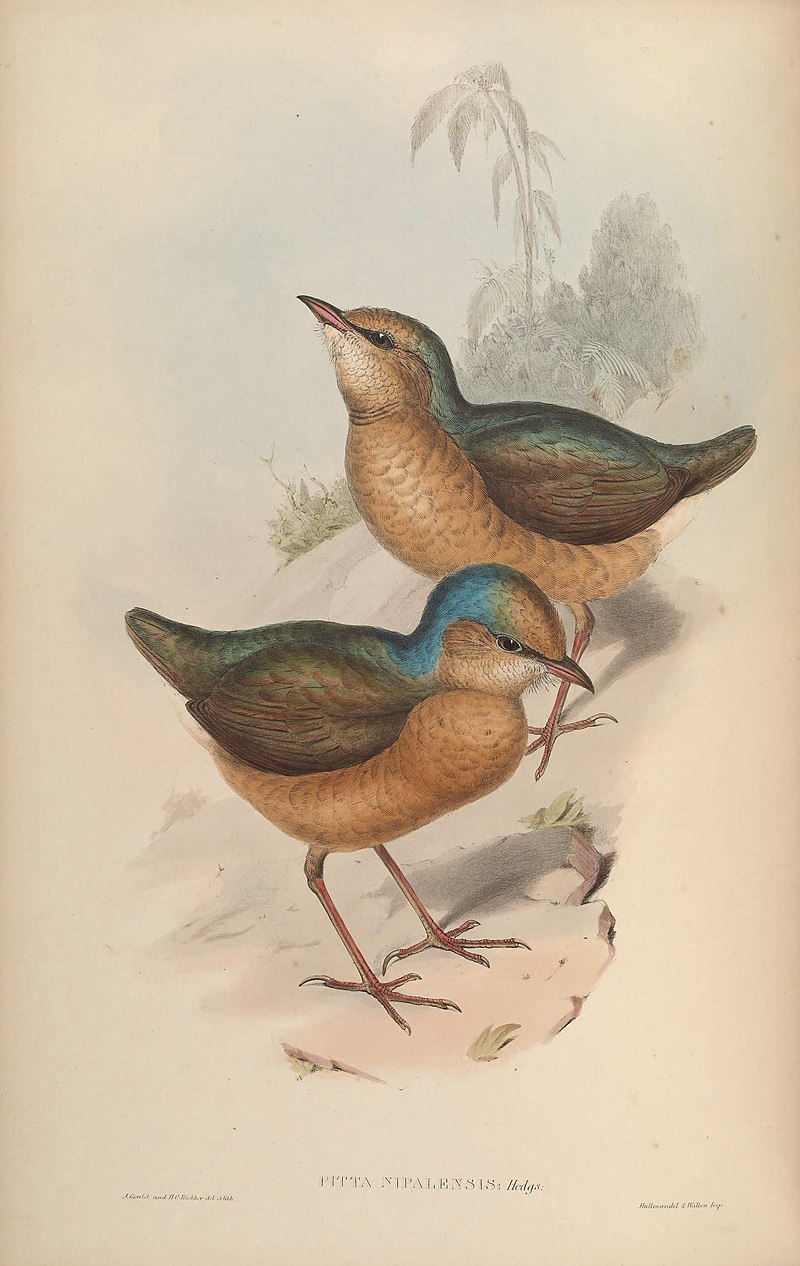
The Blue-naped Pitta is a beautiful species of bird belonging to the family Pittidae. It stands out for its bright colors, including blue and green above, with reddish-yellow coloring below.
The nape and hindneck are particularly striking in their vibrant blue hue while the tail is brown mixed with some green.
Male and female birds look similar but there’s one key difference: females have a reddish-brown hindcrown instead of blue.
This pitta can be found mainly throughout Southeast Asia in habitats such as tropical lowland forests or woodlands near rivers and streams where they feed on insects like beetles, grasshoppers, caterpillars and ants among other small invertebrates that live amongst foliage or on the ground surface.Scientific classification:
| Kingdom | Animalia |
| Phylum | Chordata |
| Class | Aves |
| Order | Passeriformes |
| Family | Pittidae |
| Genus | Hydrornis |
| Species | H. nipalensis |
11. Eared Pitta
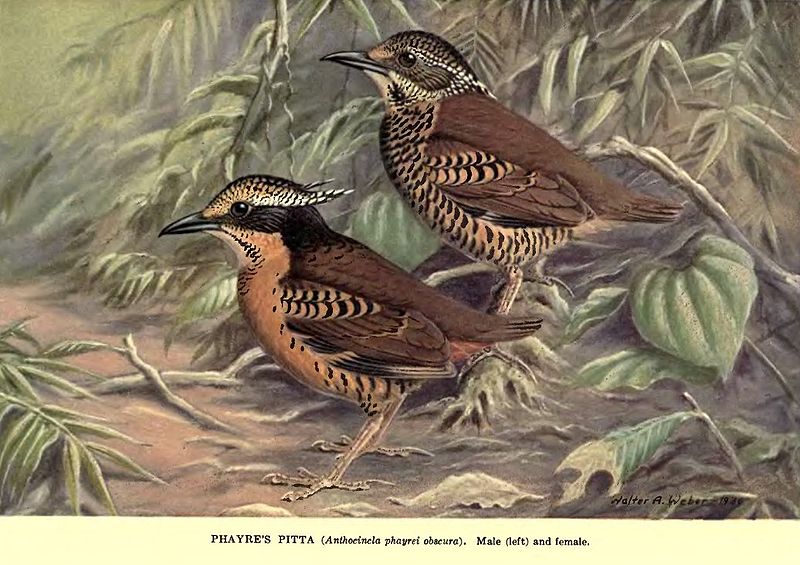
The eared pitta (Hydrornis phayrei) is a stunning species of bird found in Southeast Asia. It belongs to the Pitta family and was formerly placed into its own genus, Anthocincla, due to its unique and primitive characteristics.
Both males and females sport cryptic colors which sets them apart from other Hydrornis species that exhibit sexual dimorphism.
They are small birds with long tails measured at around 16–18 cm in length; they have black heads, olive-green wings and tail feathers as well as white underparts making them an attractive sight for any bird watcher or enthusiast.Scientific classification:
| Kingdom | Animalia |
| Phylum | Chordata |
| Class | Aves |
| Order | Passeriformes |
| Family | Pittidae |
| Genus | Hydrornis |
| Species | H. phayrei |
12. Blue-Rumped Pitta
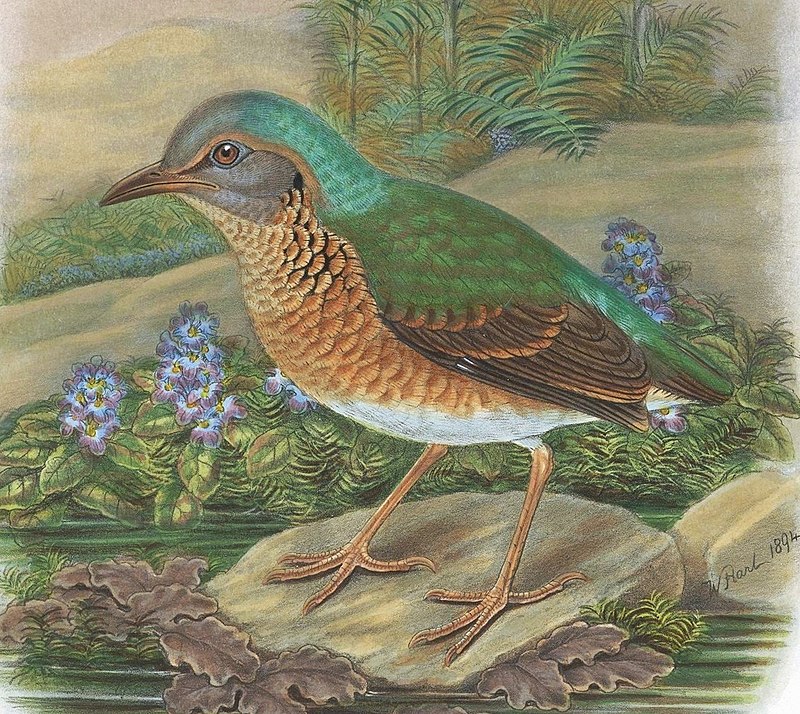
The stunning Blue-rumped Pitta is a species of bird found in parts of Cambodia, China, Laos, Thailand and Vietnam. They inhabit subtropical or tropical moist lowland forests as well as montane forests.
The birds have an overall blueish plumage with a bright yellow head and breast. Their backs are brown while the tail feathers show off shades of green and purple – making them quite eye catching.
First described by English naturalist Robert George Wardlaw-Ramsay back in 1881 from a specimen collected in Saigo; they can now be spotted throughout their native range flying between trees looking for insects to feed on.Scientific classification:
| Kingdom | Animalia |
| Phylum | Chordata |
| Class | Aves |
| Order | Passeriformes |
| Family | Pittidae |
| Genus | Hydrornis |
| Species | H. soror |
13. Black-Eared Shrike-Babbler
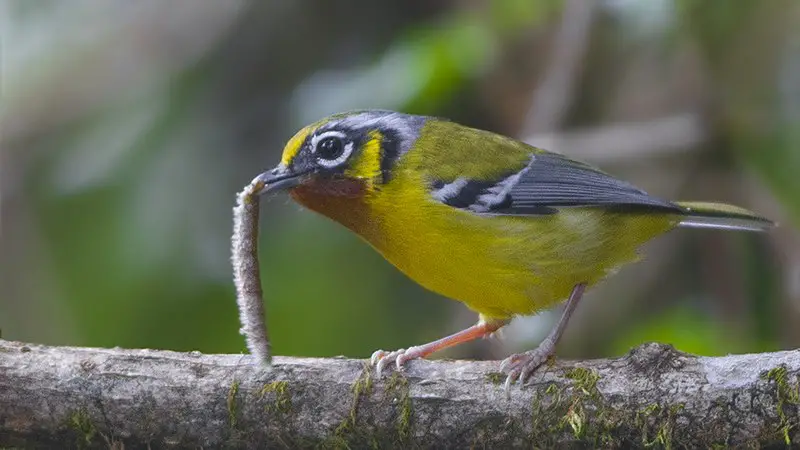
The black-eared shrike-babbler is a species of bird in the Vireonidae family found throughout Southeast Asia, particularly in the Himalayas.
Its behavior and habits resemble those of vireos due to convergent evolution, although it was traditionally considered an aberrant Old World babbler placed within the Timaliidae family.
This small bird has distinct black ear patches with white borders against its brown upperparts and greyish underparts.
It feeds on insects such as grasshoppers, caterpillars and other invertebrates while foraging among foliage or branches near forest edges.
They also eat fruits like figs during winter months when insect availability decreases significantly.
The Black-eared shrike-babbler is usually seen alone or in pairs interacting through calls that create melodious sounds echoing across their native forests habitatsScientific classification:
| Kingdom | Animalia |
| Phylum | Chordata |
| Class | Aves |
| Order | Passeriformes |
| Family | Vireonidae |
| Genus | Pteruthius |
| Species | P. melanotis |
14. Bay Woodpecker
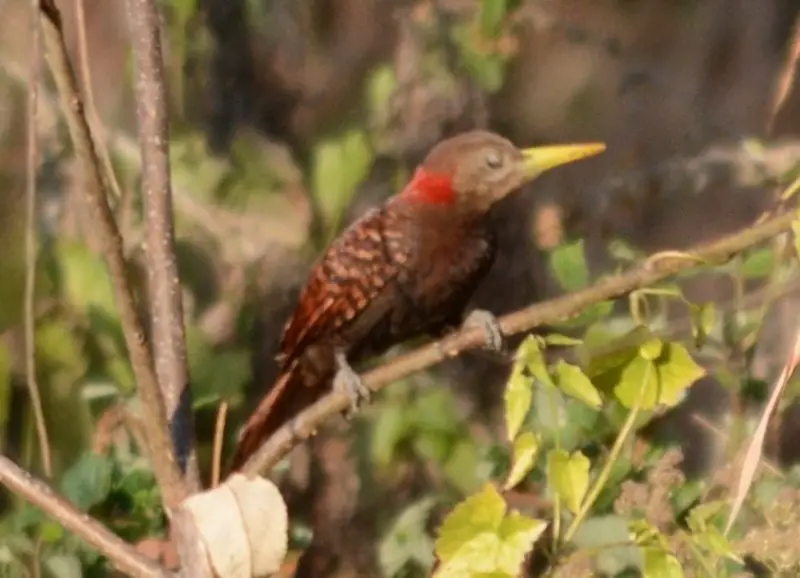
The Bay Woodpecker is a species of bird found in many parts of Asia, from Bangladesh to Vietnam. This small but colorful bird lives in subtropical or tropical moist lowland and montane forests.
It has an olive-brown back with white barring on the wings and tail feathers, while its belly is yellowish-white spotted with cinnamon brown. Its diet consists mainly of insects such as ants, beetles, termites and caterpillars.
The call of this woodpecker can be heard echoing through the trees – it’s a loud “krrr” noise.
As well as foraging for food alone or in pairs during the day time, they also use their long bills to excavate nest cavities high up into tree trunks where they lay eggs at night time.
These birds are important seed dispersers due to their constant movement between habitats which helps spread new varieties of plants throughout different areas – making them essential components within local ecosystems.Scientific classification:
| Kingdom | Animalia |
| Phylum | Chordata |
| Class | Aves |
| Order | Piciformes |
| Family | Picidae |
| Genus | Blythipicus |
| Species | B. pyrrhotis |
15. Bamboo Woodpecker
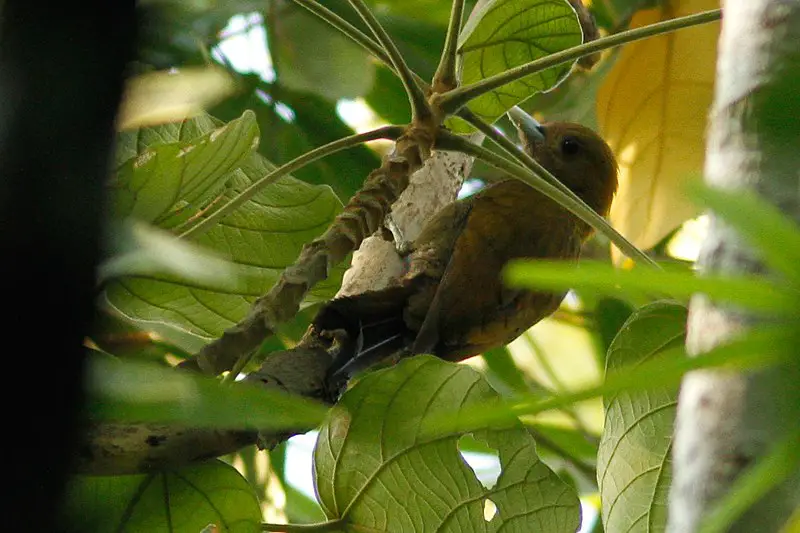
The Bamboo Woodpecker is a species of bird found in Myanmar, Laos, Thailand and Malaysia. It has distinctive green plumage with black markings on its wings and tail feathers.
Its bill is yellowish-orange at the base, becoming white towards the tip.
The woodpecker lives mainly in subtropical or tropical dry forests as well as moist lowland forests where it feeds mostly on insects hidden inside bamboo shoots or trees such as palm oil and rubber trees.
This species plays an important role in maintaining healthy forest ecosystems by helping to disperse seeds from various plant types while foraging for food among deadwood branches.
These birds are also known to drum loudly against tree trunks when communicating with other members of their flock which can be heard up to 1 km away.Scientific classification:
| Kingdom | Animalia |
| Phylum | Chordata |
| Class | Aves |
| Order | Piciformes |
| Family | Picidae |
| Genus | Gecinulus |
| Species | G. viridis |
16. Black-Breasted Thrush
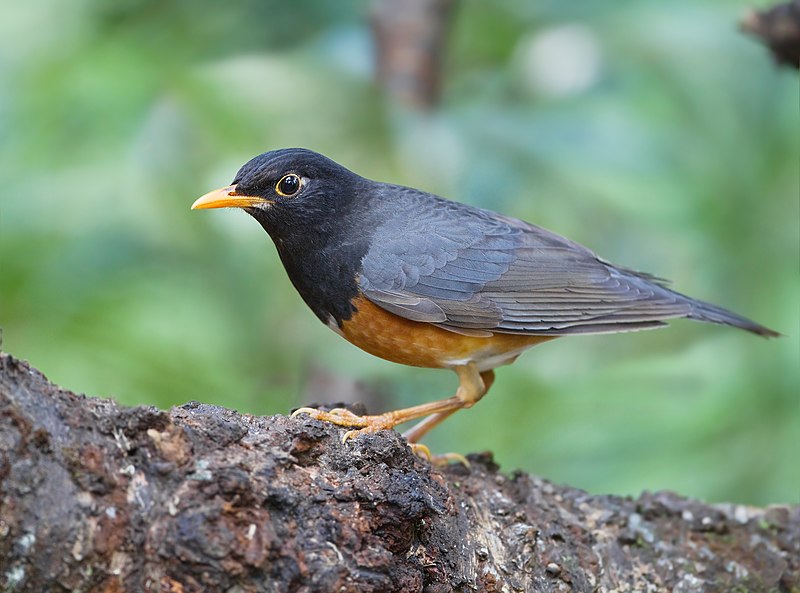
The Black-breasted Thrush is a species of bird found in northeastern India to northern Vietnam. This thrush has the same coloration on its lower parts, but males have mostly black upperparts while females are mostly grey-brown.
The common name refers to the deep black colouring of the male’s breast. It prefers subtropical or tropical moist lowland forests and feeds on invertebrates, fruits and berries.
Besides being beautiful with their contrasting colors they also have an interesting song that includes phrases made up of whistles and trills which can be heard throughout much of Southeast Asia during mating season..
They are not considered threatened although habitat loss due to deforestation could pose a challenge for them in future years if conservation efforts aren’t successfulScientific classification:
| Kingdom | Animalia |
| Phylum | Chordata |
| Class | Aves |
| Order | Passeriformes |
| Family | Turdidae |
| Genus | Turdus |
| Species | T. dissimilis |
17. Black-Chinned Yuhina
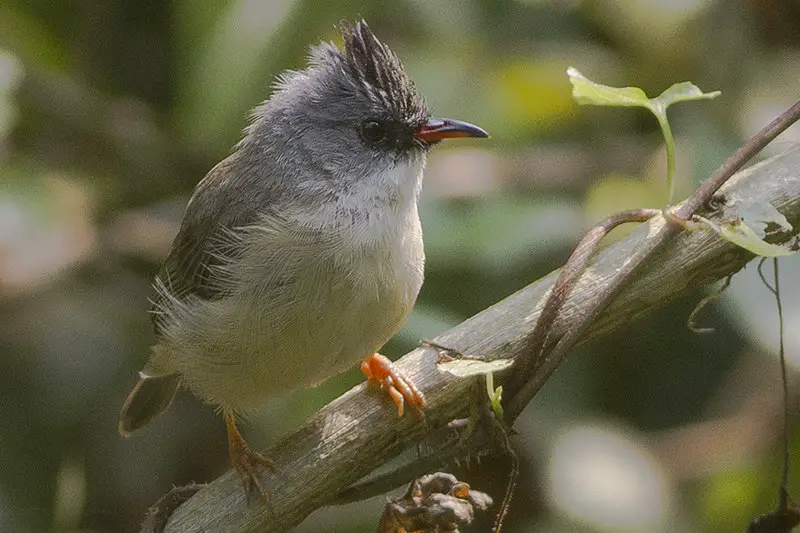
The Black-chinned Yuhina is a small bird belonging to the white-eye family Zosteropidae.
It can be found in various parts of India and Southeast Asia, from Himalayan regions eastward down through Bangladesh, Bhutan, Cambodia, Laos , Myanmar Nepal Tibet and Thailand.
These birds prefer subtropical or tropical moist lowland forests for their habitat where they feed on insects like termites that are commonly found there.
In addition to being active during day time hours these little creatures often form large flocks with other species like barbets and cuckoos when looking for food sources.
They have remarkable black chins which distinguishes them among other members of this family making them quite unique.Scientific classification:
| Kingdom | Animalia |
| Phylum | Chordata |
| Class | Aves |
| Order | Passeriformes |
| Family | Zosteropidae |
| Genus | Yuhina |
| Species | Y. nigrimenta |
18. Silver Pheasant
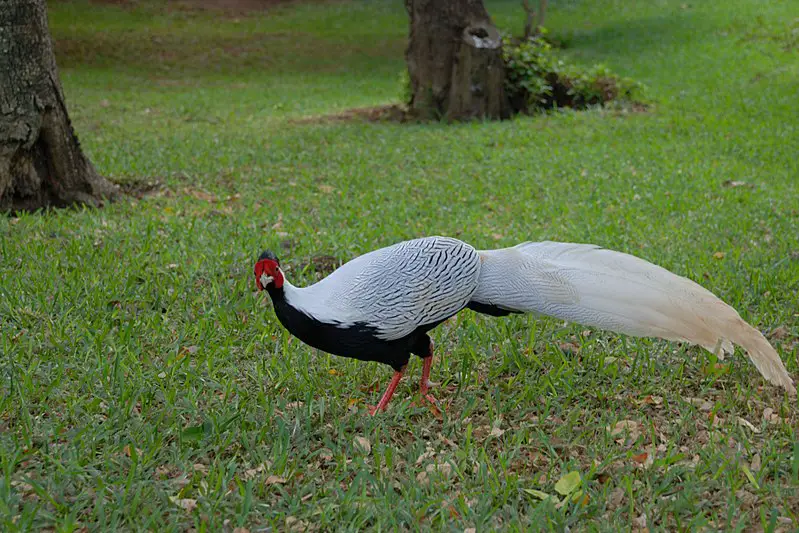
The Silver Pheasant is a stunningly beautiful bird native to parts of Southeast Asia, Eastern and Southern China. This species is known for its distinct black and white feathers in the males, while females are mainly brown.
They both have bare red faces and legs which sets them apart from other birds such as the Golden Pheasant.
The Silver pheasant lives mainly in mountain forests where it feeds on various types of insects, fruits, buds, shoots and seeds.
It has even been introduced to Argentina’s Victoria Island at Nahuel Huapi Lake.
These gorgeous creatures are also popular among aviculture enthusiasts who appreciate their majestic beauty – just be sure to provide plenty of space for these large birds if you hope to keep one as a pet.Scientific classification:
| Kingdom | Animalia |
| Phylum | Chordata |
| Class | Aves |
| Order | Galliformes |
| Family | Phasianidae |
| Genus | Lophura |
| Species | L. nycthemera |
19. Jerdon’s Bush Chat
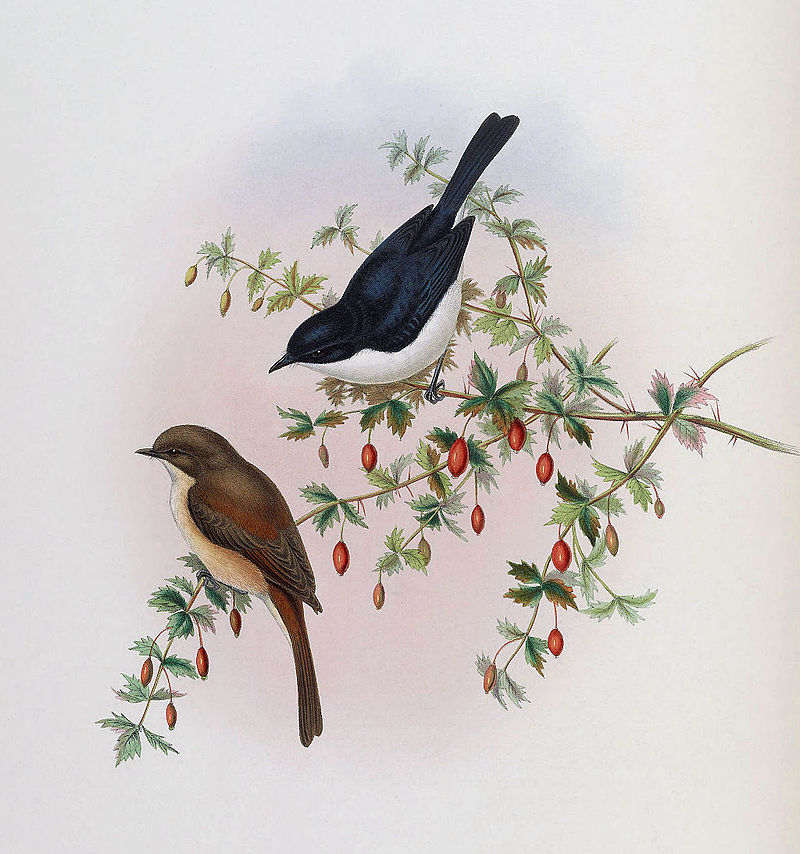
Jerdon’s bush chat is a species of bird in the Muscicapidae family. It was named after Thomas C. Jerdon, a surgeon-naturalist who had explored many parts of India and Nepal during his time.
The bird has an incredibly large range that includes Bangladesh, China, India, Laos, Nepal, Thailand and Vietnam; however it may be extinct in Myanmar.
Its westernmost habitat can be found at Sukla Phanta National Park in Nepal where they inhabit grasslands with scrubby bushes or trees nearby for nesting purposes making them easily identifiable by their brown plumage with white spots on their wings as well as a light colored head striped black towards its chin area .Scientific classification:
| Kingdom | Animalia |
| Phylum | Chordata |
| Class | Aves |
| Order | Passeriformes |
| Family | Muscicapidae |
| Genus | Saxicola |
| Species | S. jerdoni |
20. Himalayan Cutia
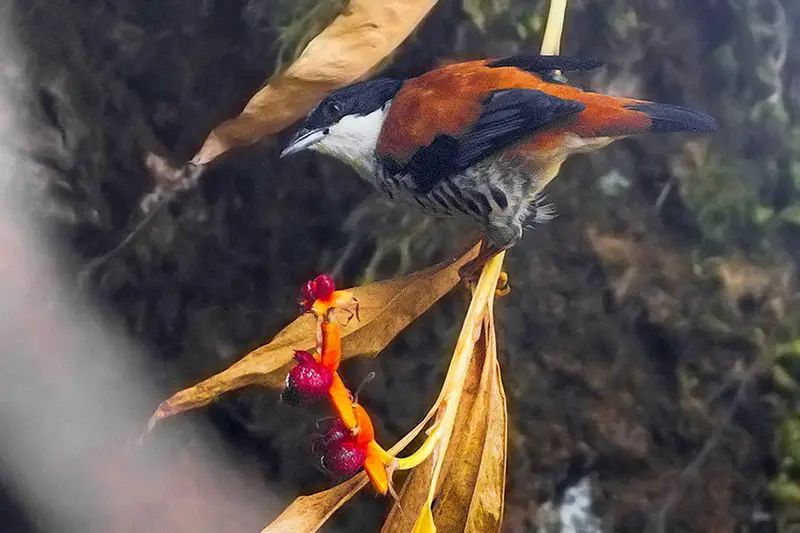
The Himalayan cutia is a small bird from the family Leiothrichidae, found in the Himalayan region. It gets its scientific name – Cutia nipalensis – from Nepali; ‘cuti’ being their word for this species of bird and ‘nipalensis’ meaning “from Nepal”.
This unique species can also be spotted in India, northern Thailand and Peninsular Malaysia. The cutting call they make while flying through the sky has become a sound of beauty to many people living nearby.
With an unmistakable pattern on its feathers along with bright red eyes, it’s no wonder that these birds are so loved by those who spot them.Scientific classification:
| Kingdom | Animalia |
| Phylum | Chordata |
| Class | Aves |
| Order | Passeriformes |
| Family | Leiothrichidae |
| Genus | Cutia |
| Species | C. nipalensis |
21. Limestone Leaf Warbler
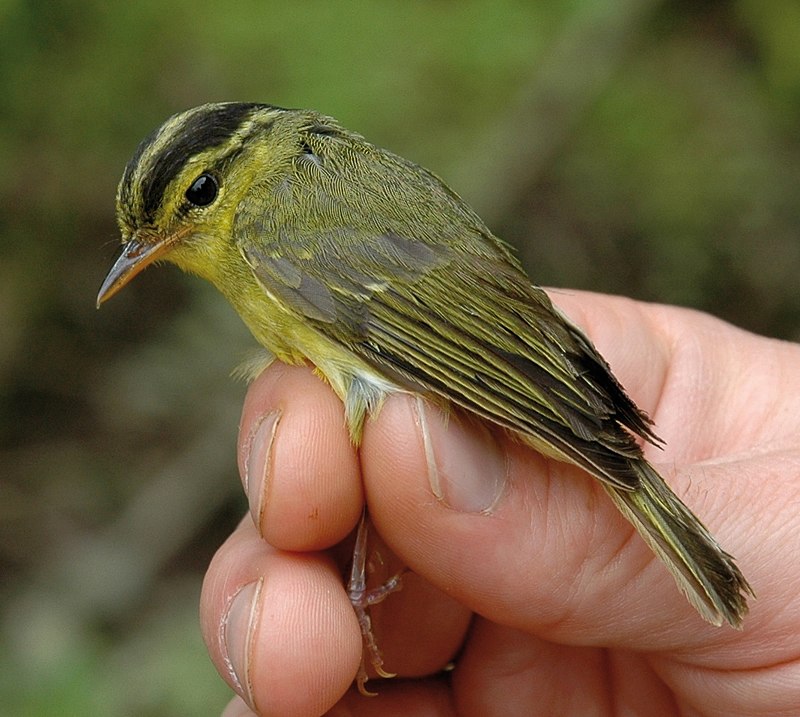
The Limestone Leaf Warbler is a species of warbler in the Phylloscopidae family. It was discovered in 1994 and mistaken for its similar relative, the Sulphur-breasted Warbler due to its almost identical plumage; however it has more rounded wings and slightly colder yellow feathers on its underside.
This passerine bird lives mainly around limestone areas with thick vegetation found throughout parts of India and China, often perching atop rocks or low trees while searching for food such as insects.
Its song consists of short trills that can be heard during morning hours when they are particularly active.
Despite being fairly common within their range, not much else is known about this mysterious species yet.Scientific classification:
| Kingdom | Animalia |
| Phylum | Chordata |
| Class | Aves |
| Order | Passeriformes |
| Family | Phylloscopidae |
| Genus | Phylloscopus |
| Species | P. calciatilis |
22. Red-Collared Woodpecker
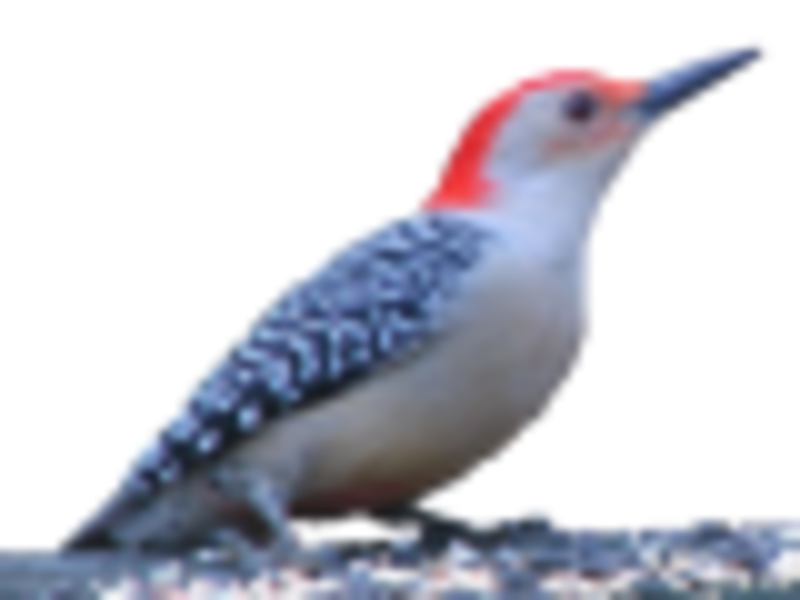
The red-collared woodpecker is a beautiful species of bird that belongs to the family Picidae. It can be found in certain parts of Cambodia, China, Laos and Vietnam living in temperate forests.
Unfortunately it is under threat due to habitat loss caused by human activity such as deforestation for agricultural land or logging.
If we want this stunning creature to remain with us for generations then we need to take action now and protect its natural environment before it’s too late.
By preserving their habitats through regulations regarding forestry practices and increased awareness about conservation efforts made on behalf of these birds, we may be able preserve them from extinction thus allowing future generations the pleasure of seeing them in our skies.Scientific classification:
| Kingdom | Animalia |
| Phylum | Chordata |
| Class | Aves |
| Order | Piciformes |
| Family | Picidae |
| Genus | Picus |
| Species | P. rabieri’ |
23. Giant Ibis
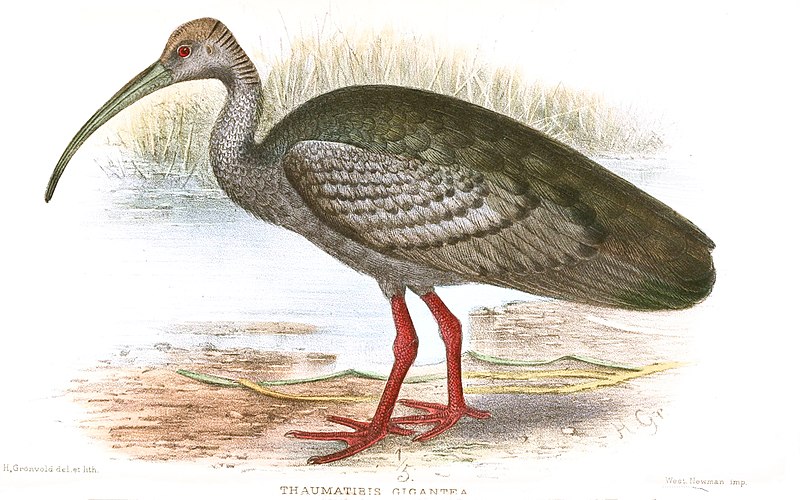
The Giant Ibis is a magnificent bird found in northern Cambodia, southern Laos and even Vietnam. It belongs to the Threskiornithidae family of wading birds and are the only species present in its monotypic genus – Thaumatibis.
These birds prefer lowland habitats such as marshes, swamps, wide rivers or flooded plains for their habitat.
Their diet comprises of small aquatic animals like fish, crabs and amphibians that they hunt with their long beaks while on land; insects make up for most of it when they take flight.
The giant ibises have faced tremendous threats from human activities like deforestation and hunting which puts them at risk of extinction; however conservation efforts are underway today to protect these beautiful creatures before it’s too late.Scientific classification:
| Kingdom | Animalia |
| Phylum | Chordata |
| Class | Aves |
| Order | Pelecaniformes |
| Family | Threskiornithidae |
| Genus | Thaumatibis Elliot, 1877[2] |
| Species | T. gigantea |
24. Grey Treepie
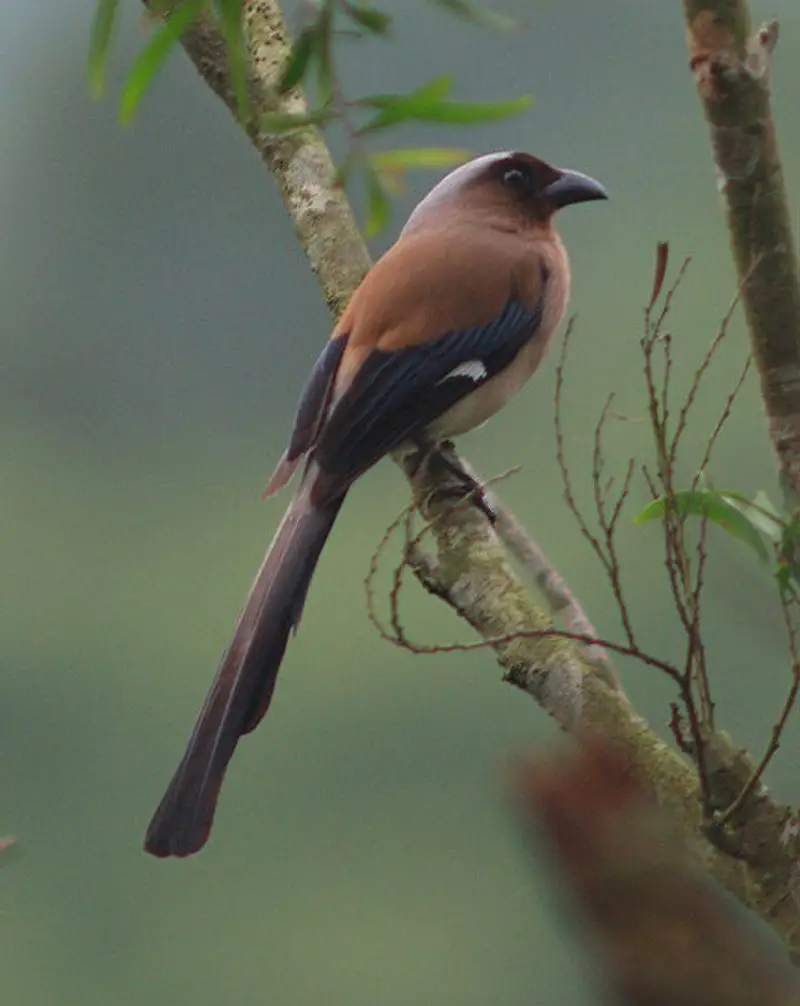
The Grey Treepie is a medium-sized bird belonging to the crow family, originally described by Robert Swinhoe in 1863. It can be found living along the foothills of the Himalayas and extending into parts of India, Indochina, southern mainland China and Taiwan.
Its plumage is mainly grey on its wings and back with white or pale yellow underparts. The tail feathers are usually black tipped with white spots.
They have strong legs adaptable for long hikes over mountainous terrain as they search for food such as insects, fruits, seeds and small reptiles like lizards etc., which make up their diet primarily.
Grey treepies are known for being highly vocal birds who communicate through a range of calls that differ between individuals making them an interesting species to observe.Scientific classification:
| Kingdom | Animalia |
| Phylum | Chordata |
| Class | Aves |
| Order | Passeriformes |
| Family | Corvidae |
| Genus | Dendrocitta |
| Species | D. formosae |